RESEARCH
Global cost of child survival: estimates from country-level validation
Coût global de la survie de l'enfant: estimations à partir de la validation au niveau du pays
Coste mundial de la supervivencia infantil: cálculos procedentes de las validaciones nacionales
Liselore van EkdomI; Karin StenbergII,*; Robert W ScherpbierIII; Louis W NiessenIV; on behalf of the ad hoc Study Group for Child Health Cost Validation
IHouse of Performance, Utrecht, Netherlands
IIWorld Health Organization, Department of Health Systems Financing, Avenue Appia 20, 1211 Geneva 27, Switzerland
IIIWorld Health Organization, Beijing, China
IVDepartment of International Health, Johns Hopkins Bloomberg School of Public Health, Baltimore, United States of America
ABSTRACT
OBJECTIVE: To cross-validate the global cost of scaling up child survival interventions to achieve the fourth Millennium Development Goal (MDG4) as estimated by the World Health Organization (WHO) in 2007 by using the latest country-provided data and new assumptions.
METHODS: After the main cost categories for each country were identified, validation questionnaires were sent to 32 countries with high child mortality. Publicly available estimates for disease incidence, intervention coverage, prices and resources for individual-level and programme-level activities were validated against local data. Nine updates to the 2007 WHO model were generated using revised assumptions. Finally, estimates were extrapolated to 75 countries and combined with cost estimates for immunization and malaria programmes and for programmes for the prevention of mother-to-child transmission of the human immunodeficiency virus (HIV).
FINDINGS: Twenty-six countries responded. Adjustments were largest for system- and programme-level data and smallest for patient data. Country-level validation caused a 53% increase in original cost estimates (i.e. 9 billion 2004 United States dollars [US$]) for 26 countries owing to revised system and programme assumptions, especially surrounding community health worker costs. The additional effect of updated population figures was small; updated epidemiologic figures increased costs by US$ 4 billion (+15%). New unit prices in the 26 countries that provided data increased estimates by US$ 4.3 billion (+16%). Extrapolation to 75 countries increased the original price estimate by US$ 33 billion (+80%) for 2010-2015.
CONCLUSION: Country-level validation had a significant effect on the cost estimate. Price adaptations and programme-related assumptions contributed substantially. An additional 74 billion US$ 2005 (representing a 12% increase in total health expenditure) would be needed between 2010 and 2015. Given resource constraints, countries will need to prioritize health activities within their national resource envelope.
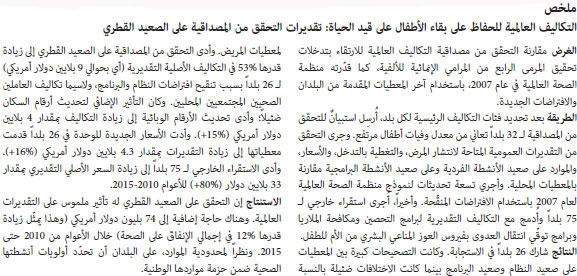
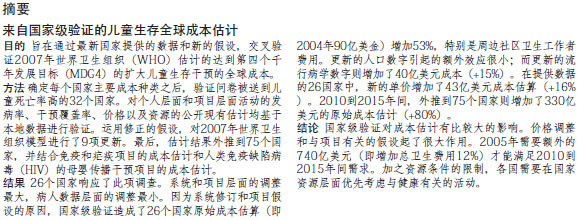
RÉSUMÉ
OBJECTIF: Effectuer une validation croisée du coût global du renforcement des interventions chirurgicales pédiatriques afin d'atteindre le quatrième objectif du Millénaire pour le développement (OMD4), selon les estimations de l'Organisation mondiale de la Santé (OMS) en 2007, en utilisant les dernières données fournies par les pays ainsi que de nouvelles hypothèses.
MÉTHODES: Après l'identification des principales catégories de coût pour chaque pays, des questionnaires de validation ont été transmis à 32 pays présentant une forte mortalité infantile. Les estimations publiquement disponibles pour l'incidence des maladies, la couverture des interventions, les tarifs et les ressources relatives aux activités au niveau individuel et au niveau des programmes ont été validées par comparaison avec les données locales. Neuf mises à jour du modèle OMS 2007 ont été réalisées grâce aux hypothèses révisées. Enfin, les estimations ont été extrapolées à 75 pays et intégrées aux estimations de coût des programmes de vaccination et de lutte contre le paludisme et des programmes de prévention de la transmission mère-enfant du virus de l'immunodéficience humaine.
RÉSULTATS: Vingt-six pays ont répondu. Les réajustements étaient les plus importants pour les données relatives aux systèmes et aux programmes, et les moins importants pour les données des patients. La validation au niveau des pays s'est traduite par une augmentation de 53% des estimations de coût d'origine (c.-à-d. 9 milliards de dollars américains de 2004 [USD]) pour 26 pays, du fait de la révision des hypothèses liées aux systèmes et aux programmes, plus particulièrement celles concernant les coûts afférents au personnel de santé communautaire. Les chiffres démographiques actualisés n'avaient que peu d'effet ajouté et les chiffres épidémiologiques actualisés augmentaient les coûts de 4 milliards de dollars américains (+15%). Les tarifs des nouvelles unités des 26 pays qui avaient fourni les données augmentaient les estimations de 4,3 milliards de dollars américains (+16%). L'extrapolation à 75 pays augmentait l'estimation des tarifs d'origine de 33 milliards de dollars américains (+80%) sur la période 2010-2015.
CONCLUSION: La validation au niveau des pays a eu un impact significatif sur les estimations de coût. Les hypothèses d'ajustement des tarifs et les hypothèses liées aux programmes y ont largement contribué. Ce sont 74 milliards de dollars américains de 2005 (représentant une augmentation de 12% dans les dépenses de santé totales) qui seraient nécessaires entre 2010 et 2015. Au vu des contraintes de ressources, les pays devront établir les priorités des activités sanitaires dans leur enveloppe de ressources nationale.
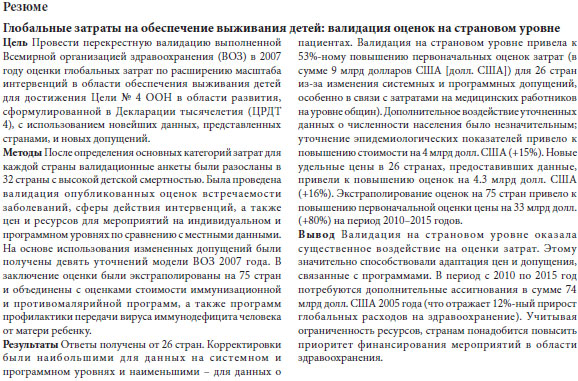
RESUMEN
OBJETIVO: Realizar una validación cruzada del gasto mundial correspondiente al aumento de las intervenciones para la supervivencia infantil, calculado en 2007 por la Organización Mundial de la Salud (OMS), con los últimos datos proporcionados por los países y los nuevos supuestos, para alcanzar el Objetivo del Milenio 4 de la OMS.
MÉTODOS: Tras identificar las principales categorías del gasto de cada país, se enviaron los cuestionarios de validación a 32 países con una mortalidad infantil elevada. Se cotejaron los datos locales con las estimaciones a disposición pública de la incidencia de enfermedades, la cobertura de la intervención, los precios y los recursos de las actividades realizadas a nivel individual y dentro del programa. Con los supuestos revisados, se elaboraron nueve actualizaciones del modelo de la OMS de 2007. Por último, las estimaciones se extrapolaron a 75 países y se combinaron con las estimaciones del coste de los programas de vacunación y contra la malaria, así como de los programas de prevención de la transmisión maternofetal del virus de la inmunodeficiencia humana.
RESULTADOS: Respondieron 26 países. Los ajustes fueron mayores en los datos del sistema y de los programas que en los datos de los pacientes. La comprobación a nivel nacional produjo un aumento del 53% de los cálculos originales del gasto (es decir, 9 000 millones de dólares estadounidenses en 2004 [US$] en 26 países, debido a la revisión del sistema y de los supuestos del programa, especialmente en lo referente a los costes del personal sanitario comunitario). El efecto adicional de las cifras actualizadas de la población fue pequeño; las cifras epidemiológicas actualizadas hicieron que el coste aumentara en US$ 4 000 millones (+15%). Los nuevos precios unitarios de los 26 países que aportaron sus datos aumentaron las estimaciones en US$ 4 300 millones (+16%). La extrapolación a los 75 países provocó un aumento de la estimación original del precio de US$ 33 000 millones (+80%) para el periodo comprendido entre 2010 y 2015.
CONCLUSIÓN: La validación a nivel nacional tuvo un efecto considerable en las estimaciones del gasto mundial. Las adaptaciones de los precios y los supuestos relacionados con los programas contribuyeron de forma significativa a dicho aumento. Entre 2010 y 2015 harán falta US$ 74 000 millones más (de 2005), lo que significa un aumento del 12% del gasto sanitario total. En vista de las limitaciones de los recursos, los países deberán dar prioridad a las actividades sanitarias en sus dotaciones presupuestarias nacionales.
Introduction
In keeping with the fourth Millennium Development Goal (MDG4), nations have pledged to reduce child mortality by two-thirds between 1990 and 2015. This calls for a scale-up of child survival interventions, whose global cost the World Health Organization (WHO) recently estimated for 75 countries that have a high burden of mortality among children aged less than five years.1 In an effort to support the countries in greatest need, WHO's Department of Child and Adolescent Health and Development (CAH) has identified 33 countries (Appendix A, available at: http://www.who.int/choice/publications/p_2011_cost_validation_webannexes.pdf) that together contribute 78% of all deaths among children under 5 years of age.
Updated and improved global data on child health have recently become available. Also available now are updated estimates on the prevalence of malnutrition; new intervention coverage estimates made available by Countdown-to-20152; updated price estimates from the WHO-CHOICE project3 and updated estimates of the resources needed to scale up immunization,4 malaria5 and prevention of mother-to-child transmission (PMTCT) of human immunodeficiency virus (HIV) programmes.6
Although global price estimates for the scale-up of packages of selected child health interventions are regularly published,7,8 to our knowledge none has been empirically validated against existing country data.9 Empirical validation differs from the type of conceptual validation by experts that we first conducted.1 This paper reports on the results of this country-level empirical validation process, for which we use country feedback data in conjunction with new, published global data on epidemiology and prices. It presents a validated and revised global price tag for the scale-up of child survival interventions required to attain MDG4 and serves as an investment guide for governments and their development partners.
Methods
We used the original cost projection developed by WHO to derive the 2007 global price tag for child survival. The validation comprised only the key interventions included in the CAH model, including the management of pneumonia, diarrhoea and severe malnutrition, as well as nutrition counselling (complete list available in Appendix B, available at: http://www.who.int/choice/publications/p_2011_cost_validation_webannexes.pdf).
We identified major cost drivers by country and then sent a validation questionnaire covering these cost drivers to 32 countries with high child mortality. Each data input category for the costing model (disease incidence, intervention coverage and prices and input volumes for individual-level and programme-level activities) was validated against local data. Original assumptions were replaced by local data or by recent updated estimates on incidence, coverage and price. Additional costs were calculated through nine model scenarios that assessed the effects of: (i) the validation and of updated epidemiologic and coverage data; (ii) population change and scale-up sensitivity ranges; and (iii) updated unit price estimates. These cross-validated results were subsequently extrapolated to 75 countries. Lastly, these final estimates were combined with published estimates of the resources needed to scale up immunization, malaria interventions and PMTCT to compute a revised total global price tag.
Cost drivers
We retained the components of the original price tag, which included interventions addressing the major causes of death among children aged less than 5 years:10,11 newborn sepsis, pneumonia, diarrhoea, malaria, PMTCT and malnutrition. As in our original study,12 we based cost estimates on an ingredients approach, and we focused on validating input assumptions using patient-level and programme-level costs.
Patient costs refer to the costs of an intervention at the point where services (e.g. drugs, supplies) are delivered to a client. Patient costs vary depending on disease burden, current intervention coverage, differences in case management protocols and visit prices. Programme costs are expenses incurred at the district, province or country administrative level (e.g. in-service training for health workers or information, education and communication activities).13 Costs vary across countries depending on the choice of delivery mechanisms and level of investment in areas such as health worker training, health-care infrastructure and mechanisms for generating service demand in the community.
It was not feasible to validate every single assumption in the original model, so our questions referred to cost drivers, defined as follows. Interventions were identified as cost drivers when the relative proportion of an intervention contributed to 10% or more of overall patient costs in the specific country. A programme cost category was identified as a cost driver if it fulfilled the following two criteria: (i) the cost category contributed to 10% or more of the overall programme cost estimated for the specific country, and (ii) the particular component accounted for at least 70% of the costs of that category. More details are provided in Appendix C, available at: http://www.who.int/choice/publications/p_2011_cost_validation_webannexes.pdf
Survey instrument and analysis
A self-administered questionnaire was developed and sent to WHO experts based in 32 countries with high child mortality in all 6 WHO regions (Appendix A). These experts, responsible for child health in each WHO country office and usually having a medical background, were the first point of contact. The respondents liaised with ministry of health officials responsible for child health to jointly review the costing assumptions and input data used by WHO to derive cost estimates. Involvement of child health staff at the ministries was intended to ensure that the replies obtained were nationally representative and in line with national policies. The data collection verification process lasted from 2 to 4 months in each country.
The survey contained two types of questions: generic questions applicable to all countries and country-specific questions covering each country's cost drivers (Appendix C and Box 1). The survey showed the country-specific values used for the original calculations and prompted respondents to review each one and to explicitly indicate if they agreed or disagreed with these estimates. Respondents who disagreed with the original assumption were asked to provide alternative data and their sources (Appendix A).
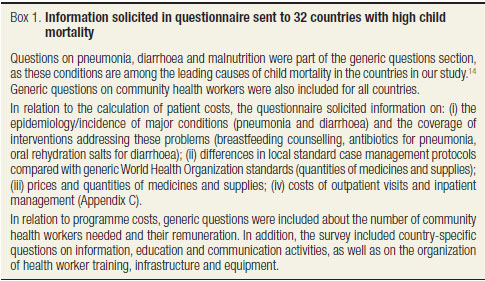
For data quality control, we asked respondents to: (i) clearly state their reference source and (ii) indicate if health ministry officials agreed with the new data.
Country responses were classified into four categories and acted upon as follows:
i) valid agreement: the original assumption was considered valid by the respondent and remained unchanged;
ii) valid disagreement: the newly validated information was considered to be adequately supported and was used in place of the original assumption;
iii) invalid disagreement: the newly validated information was considered to be inadequately supported and the original assumption was maintained;
iv) information not provided: the original estimate remained unchanged.
Price adjustments
Cost data were provided by countries in their local currencies and were converted to 2004 United States dollars (US$). When an input price was reported in US$ for a tradable good (such as medicines), we used the US$ deflation rate. When respondents provided input prices in local currency units, we applied average annual inflation rates obtained from the International Monetary Fund. When input prices for non-tradable goods such as staff salaries were provided in US$, they were converted into local currency units for the equivalent year, deflated to the 2004 level using the country-specific local currency deflation rate, and then converted to 2004 US$ equivalents.
Stepwise validation and estimate updates
Table 1 lists nine successive model estimates grouped into three categories: (i) validation (V), (ii) sensitivity analyses (S), and (iii) information updates (U). In each successive model estimate new information was added in a stepwise fashion to a preceding estimate. When country-validated data had been provided, they were maintained and not replaced in subsequent models. The stepwise presentation shows the net effect of each step (Table 1 and Appendix D, available at: http://www.who.int/choice/publications/p_2011_cost_validation_webannexes.pdf).
Model V estimates show the effect of adding new and validated country data to the original 2007 estimates. The U1-U4 model estimates show the effect of successively updating the data on population, disease incidence15,16 and intervention coverage,2 while Models S1-S3 show the effect of changes in demographic figures and in the assumed progress of the scale-up process. Model U5 estimates present the effect of recent unit price updates by WHO-CHOICE, which were performed by using new input values for the independent variables in the CHOICE regression analysis.3
Extrapolation to 75 countries
WHO's Commission on Macroeconomics and Health (CMH) has developed the only index available to date for classifying countries' health systems into four different levels of strength based on constraints other than lack of funds (e.g. constraints related to demand and care-seeking, health sector policy and broader economic and political factors).17 We estimated the average percentage increase in the projected cost of child survival interventions and related activities, by CMH category, for the 26 countries included in Model U5. The original costs for the remaining 49 countries were then increased in accordance with this adjustment factor. In this manner we extrapolated the results to all 75 countries that together accounted for 94% of all child deaths in the world (the 32 countries included in the validation accounting for 78% of such deaths). Finally, we incorporated recently updated price tags for immunization and malaria programmes and for PMTCT.
Results
Validating and adapting global cost assumptions
More than 80% (26/32) of the countries with high child mortality rates responded. This included countries from all regions, the majority (12) of them in the African Region, as outlined in Appendix A. The level of agreement with the generic assumptions used for the original global cost estimates varied substantially among country respondents, as shown in Fig. 1. It ranged from 80% agreement to 100% disagreement, although for specific areas little information was available.
Country-level information on the incidence of common childhood illnesses, especially pneumonia and diarrhoea, was particularly scarce. When available, the data provided by the countries did not conform to our quality criteria. Of the 26 respondent countries, 17 (65%) provided updated information on the coverage of pneumonia and diarrhoea management interventions. Demographic and Health Surveys were the source of information for all countries (Appendix A). About 65% of the respondent countries provided no data on the coverage of breast feeding counselling.
Not surprisingly, agreement on drug prescription quantities was strong; 77% of the respondents agreed with the global default estimates for drugs used to treat pneumonia and diarrhoea, based on standardized WHO treatment guidelines. Most disagreement had to do with the country's choice of first-line treatments (e.g. co-trimoxazole versus amoxicillin for pneumonia).
A total of 11 countries reported updated prices for oral rehydration salt sachets. Nine countries reported a price that was, on average, 50% higher than the original global median price. Less information was provided about the average cost of outpatient visits and hospital admissions, a reflection of the scarcity of cost studies at the country level and/or the limited use of their results for national planning.
Upon request, 13 countries provided updated per diem costs for Integrated Management of Childhood Illness in-service training participants. On average, the new per diem amounts were more than double the original estimates. Similarly, the original figures for community health worker (CHW) pay were reported as inaccurate by 16 of the 26 respondent countries. Nine countries presented higher figures, four reported a lower amount and three reported that CHWs received no remuneration.
Consensus was limited on the CHW density needed to support family care practices and community-based care. Of 10 countries that provided data, 5 reported a density higher than the model assumption of 1 CHW per 1000 rural residents and 1 CHW per 1500 urban residents, whereas 5 reported a lower density. The updated numbers of existing CHWs that were provided by respondent countries also differed from the estimates available in the WHO database,14 most likely owing to differences in definition. For the 16 countries that reported using CHWs, the new data resulted in a median increase of 53% in CHW remuneration levels, which emerged as a major cost component.
Validating outcomes for 26 countries
Table 2 shows the new cost estimates based on validated country inputs. New country-level data (Model V) resulted in a 53% increase in total costs for the 26 countries surveyed. When new population data were provided (U1), costs fell by 4%. With updated incidence calculations for severe malnutrition (U2), costs increased further, to 77% more than the original estimate. Updating intervention coverage lowered total costs somewhat, to 61% of the original estimate (U3). Combining these updates (U4) yielded a total increase of 63%.
The validation survey (V) showed relatively robust patient cost estimates (an increase of 20%). Programme cost estimates, however, more than doubled (+140%) in Model V. CHW expenditures contributed the most to this increase. Such expenditures increased by 280% (range: 0-1146%), on average, for the 19 countries that provided feedback, mainly because of higher updated figures for CHW remuneration (rather than number of CHWs). The second most influential adjustment was an average doubling of infrastructure costs (+103%), mostly comprised of the equipment needed to upgrade existing hospitals. As a result of the validation process, the cost of training and of information, education and communication activities decreased to 91% and 78% of the original cost estimates, respectively (Appendix D).
The sensitivity analysis (S2, S3) showed that population size was not a major cost driver; low and high population estimates caused a change of only 2% to 3% in total costs. Changing the model to a linear scale-up (S1) lowered total costs by 11%. Model U5 results in a 16% increase in overall costs when updated WHO-CHOICE prices for the year 2005 were used.3
Overall our analysis showed that country feedback affected costs the most. Additional substantial effects resulted from updated WHO-CHOICE prices (U5) and from improved estimates of the incidence of severe malnutrition (U2). The design of the scale-up curve (S1) had an important effect (-11%), along with updated programme coverage figures (+5%). Population projections (U1) had a small effect; the shift from 2002 to 2008 United Nations projections caused a 3% cost decrease and the use of low versus high projections had a moderate effect (range: +2 to -3%). We are referring to gross changes; the importance of these factors may vary across countries.
As shown in Fig. 2, the original price tag substantially underestimated total costs. After the validation, the median per capita investment needed in 2015 increased by 24% for the 26 countries surveyed (range: -31% to +498%) (Appendix E, available at: http://www.who.int/choice/publications/p_2011_cost_validation_webannexes.pdf).
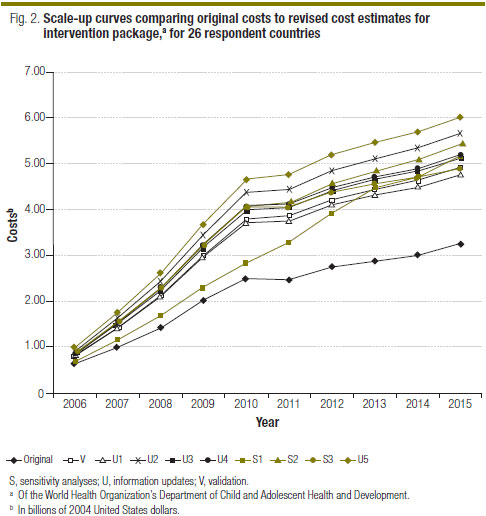
We extrapolated the new findings to estimate the costs (in 2005 US$ for consistency with recent publications from the High Level Taskforce on International Innovative Financing for Health Systems and others) for the 75 countries having high child mortality rates, based on the percentage change, per CMH category, observed among the countries in our survey. Our analysis, based on revised estimates and on new published cost estimates for PMTCT,9 immunization18 and malaria programmes,19 has shown the need to invest an additional US$ 74 billion from 2010 to 2015, starting with US$ 10 billion in 2010 and reaching US$ 14 billion by 2015 (Table 3). This represents an increase of US$ 33 billion (+80%) over previous estimates for the span of 6 years. The planned introduction of new vaccines resulted in increased immunization costs. On the other hand, the incremental resources needed for PMTCT decreased due to recent progress in scaling up and to new, lower estimates of the incidence of HIV infection.
The newly derived costs correspond to a per capita increase of US$ 2.6 in total health expenditure in 2015 relative to 2007. As shown in Fig. 3, countries with weak health systems (CMH1) need to make the greatest investment; in such countries, the additional resources needed per capita are two to three times greater than in countries belonging to CMH categories 3 and 4. Countries with high child mortality rates in the Eastern Mediterranean Region were found to require the greatest investment (Appendix F, available at http://www.who.int/choice/publications/p_2011_cost_validation_webannexes.pdf, presents the additional funds needed per capita by WHO region).
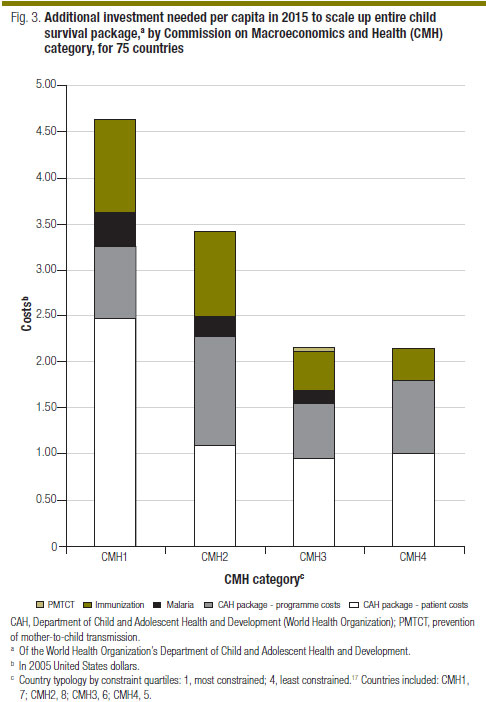
In response to the United Nations Millennium Declaration, governments have committed themselves to scaling up health services to reach the MDGs.20Fig. 4 shows that for all 26 survey countries combined, the additional investment needed would represent a median increase of approximately 12% (range: 1-55%) over the total health expenditure for 2007. Countries in CMH categories 1 and 2 would require a median increase of 18% above 2007 levels, compared with 6% for countries in CMH categories 3 and 4.
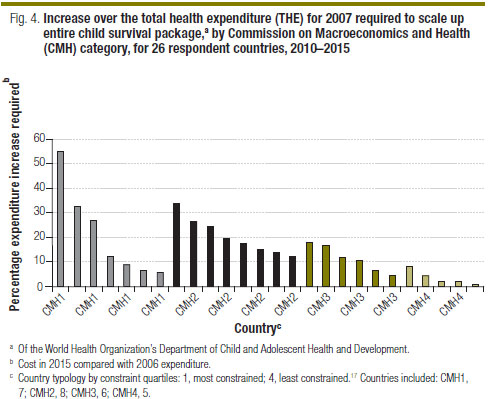
Discussion
Our revised estimate of the global price tag for selected child survival packages for the period 2010-2015 is 74 billion in 2005 US$. Incorporating the country information received resulted in an 80% increase in our 2007 global estimates. Patient cost estimates were relatively robust. Country respondents reported agreement with the treatment protocols recommended by WHO, although some countries reported prices higher than the original estimates. The wide variation in drug prices among countries has important policy implications for child health programme financing.21,22 Epidemiologic cost drivers are also important: a change in the estimated incidence of severe malnutrition alone increased original costs by 15%. The original price tag, relying on generic model defaults, resulted in considerable underestimation. Programme cost estimates increased substantially (+140%). A significant share of the total costs corresponded to health systems resources related to service delivery.
While our empirical validation reduced some measurement uncertainties, others pertaining to the scale-up process and specific implementation strategies remain.23-25 The debate surrounding facility-based versus community-based care, for example, is likely to continue. While facility-based care may prevent the more severely ill children from dying,26 access to those facilities is limited. Timely community-based care can prevent deaths by increasing access and preventing children from becoming severely ill.27 With improved standardization of care delivery options, systematic costing research can indicate the resource implications for each option, thus informing government programme strategies about the most cost-efficient alternatives.
Our study has also shown that essential country-level epidemiological data (e.g. incidence rates or cause-specific mortality figures) are rarely available.28 Data on the provision of essential child survival services are rare; 65% of the survey respondents could not provide data on breastfeeding counselling. Countries depend extensively on data that are synthesized and disseminated internationally. Existing information, particularly regarding current epidemiological trends, needs to be more widely disseminated. Needs-based planning requires more routine data collection at the local level and more economic research. Internationally comparable data on community healthy workers are lacking. This points to the need to develop comparable human resource estimates, an area in which human resources for health observatories can play an important role.29
Recent analyses have highlighted the resource needs associated with different scale-up strategies.30 National-level costing is needed for national planning involving local stakeholders and to determine the actual resources required to scale up strategies in a manner that accounts for local economies of scale. Child health planning should be conducted in conjunction with broader health sector planning. Given resource constraints, countries will need to prioritize health activities within their national resource envelopes.
The relative lack of information on country-level spending on child health complicates priority setting.31 Better instruments and processes, such as sub-accounts for child health32 and the monitoring of current (under-)spending, strengthen the case for investing in child survival and help direct resources towards effective uses. Both external and in-country financing can play a key role, especially in countries with weak health systems. The recent launch of a Global Plan for Maternal, Newborn and Child Health may increase partnerships around country plans to fund activities in this area.33 While donors are pledging increased resources for maternal and child health,34 developing country governments need to raise even more funds. Our empirical revision revealed an 80% increase in the global price tag for scaling up child survival interventions, which means that countries must reassess their budget allocation towards child health if they are to reach MDG4. When possible, options should be explored to increase national health expenditures: the estimated resource needs are equivalent to a gradual increase of 12% over 2007 levels. 
Acknowledgements
At the time this study was conducted Liselore van Ekdom, Health Economist, was affiliated with the Erasmus School of Economics and Institute of Health Policy and Management, Erasmus University, Rotterdam, Netherlands, and Robert W Scherpbier was a Medical Officer with the Department of Child and Adolescent Health and Development, World Health Organization, Geneva, Switzerland.
The authors thank the following for their collaboration during this study: members of the Ad Hoc Study Group for Child Health Cost Validation who supported this research; Faduyile Adetomowo, Carlos Avila-Figueroa, Geoffrey Bisoborwa, Richard Cibulskis, Teshome Desta, Chris Drasbek, Dainah Fajardo, Suzane Farhoud, Abuova Gaukhar, Phanuel Habimana, Job Hawap, Raymond Hutubessy, Theopista John, Abbas Uddin Khan, Brigitte Kini, Mehmet Kontas, Sudhansh Malhotra, Emmalita Manalac, Elisabeth Mason, Martha Mejía, Khounphet Mongkhongkham, Assumpta Muriithi, Juliet Nabyonga, Godwin Ntadom, Josephine Obel, Mikael Ostergren, Sergio Pieche, Mona Rakha, Severoni Santino, Tessa Tan-Torres Edejer, Tinu Taylor, Basak Tezel, Marianna Trias, Daisy Trovoada, Victoria de Urioste Blanco, Severin von Xylander and Edwin Ylagan.
Competing interests: None declared.
References
1. Stenberg K, Johns B, Scherpbier RW, Tan-Torres Edejer T. A financial road map to scaling up essential child health interventions in 75 countries. Bull World Health Organ 2007;85:305-14. doi:10.2471/BLT.06.032052 PMID:17242750
2. Bryce J, Daelmans B, Dwivedi A, Fauveau V, Lawn JE, Mason E et al.; Countdown Coverage Writing Group. Countdown to 2015 Core Group. Countdown to 2015 for maternal, newborn, and child survival: the 2008 report on tracking intervention coverage. Lancet 2008;371:1247-58. doi:10.1016/S0140-6736(08)60559-0 PMID:18406859
3. CHOosing interventions that are cost effective (WHO-CHOICE) [Internet]. WHO-CHOICE. Geneva: World Health Organization; 2010. Available from: http://www.who.int/choice/en [accessed 27 January 2011] .
4. Wolfson LJ, Gasse F, Lee-Martin S-P, Lydon P, Magan A, Tibouti A et al. Estimating the costs of achieving the WHO-UNICEF Global Immunization Vision and Strategy, 2006-2015. Bull World Health Organ 2008;86:27-39. doi:10.2471/BLT.07.045096 PMID:18235887
5. Kiszewski A, Johns B, Schapira A, Delacollette C, Crowell V, Tan-Torres T et al. Estimated global resources needed to attain international malaria control goals. Bull World Health Organ 2007;85:623-30. doi:10.2471/BLT.06.039529 PMID:17768521
6. What countries need: investments needed for 2010 targets. Geneva: United Nations Joint Programme on HIV/AIDS; 2009. Available from: http://data.unaids.org/pub/Report/2009/jc1681_what_countries_need_en.pdf [accessed 28 January 2011] .
7. Bryce J, Black RE, Walker N, Bhutta ZA, Lawn JE, Steketee RW. Can the world afford to save the lives of 6 million children each year? Lancet 2005;365:2193-200. doi:10.1016/S0140-6736(05)66777-3 PMID:15978927
8. Scaling up nutrition what will it cost? Washington: The World Bank; 2010.
9. Niessen LW. Roads to health - multi-state modelling of population health and resource use. Amsterdam: Dutch University Press; 2002.
10. Bryce J, Boschi-Pinto C, Shibuya K, Black RE; WHO Child Health Epidemiology Reference Group. WHO estimates of the causes of death in children. Lancet 2005;365:1147-52. doi:10.1016/S0140-6736(05)71877-8 PMID:15794969
11. Bhutta ZA, Ahmed T, Black RE, Cousens S, Dewey K, Giugliani E et al.; Maternal and Child Undernutrition Study Group. What works? Interventions for maternal and child undernutrition and survival. Lancet 2008;371:417-40. doi:10.1016/S0140-6736(07)61693-6 PMID:18206226
12. Department of Child and Adolescent Health and Development & Department of Health Systems Financing. Methodology and assumptions used to estimate the cost of scaling up selected child health interventions (technical working document). Geneva: World Health Organization; 2005. Available from: http://www.who.int/whr/2005/td_one_en.pdf [accessed 27 January 2011] .
13. Johns B, Baltussen R, Hutubessy R. Programme costs in the economic evaluation of health interventions. Cost Eff Resour Alloc 2003;1:1. doi:10.1186/1478-7547-1-1 PMID:12773220
14. World health statistics 2009. Geneva: World Health Organization; 2009. Available from: http://www.who.int/whosis/whostat/2009/en/index.html [accessed 28 January 2011] .
15. Garenne M, Willie D, Maire B, Fontaine O, Eeckels R, Briend A et al. Incidence and duration of severe wasting in two African populations. Public Health Nutr 2009;12:1974-82. doi:10.1017/S1368980009004972 PMID:19254427
16. World population prospects: the 2008 revision population database [Internet]. New York: United Nations, Department of Economic and Social Affairs, Population Division; 2009. Available from: http://esa.un.org/UNPP/ [accessed 28 January 2011] .
17. Ranson MK, Hanson K, Oliveira-Cruz V, Mills A. Constraints to expanding access to health interventions: an empirical analysis and country typology. J Int Dev 2003;15:15-39. doi:10.1002/jid.964
18. Wolfson LJ, Gasse F, Lee-Martin S-P, Lydon P, Magan A, Tibouti A et al. Estimating the costs of achieving the WHO-UNICEF Global Immunization Vision and Strategy, 2006-2015. Bull World Health Organ 2008;86:27-39. doi:10.2471/BLT.07.045096 PMID:18235887
19. Constraints to scaling up the health Millennium Development Goals: costing and financial gap analysis. Geneva: World Health Organization; 2009. Available from: http://www.who.int/choice/publications/d_ScalingUp_MDGs_WHO_report.pdf [accessed 28 January 2011] .
20. United Nations Millenium Declaration (General Assembly Resolution 55/2). New York: United Nations; 2000. Available from: http://www.un.org/millennium/declaration/ares552e.pdf [accessed 28 January 2011] .
21. Report of the Workshop on Differential Pricing and Financing of Essential Drugs (WHO and World Trade Organization Secreteriats Norwegian Foreign Affairs Ministry). Washington: Global Health Council; 2001. Available from: http://apps.who.int/medicinedocs/en/d/Jh2951e/2.3.2.html [accessed 27 January 2011] .
22. de Joncheere K, Haaijer-Ruskamp FM, Rietveld AH, Dukes MNG. Scope of the problem. In: Drugs and money, prices, affordability and cost containment. Geneva: World Health Organization; 2003. Available from: http://apps.who.int/medicinedocs/pdf/s4912e/s4912e.pdf [accessed 27 January 2011] .
23. Bitrán y Asociados & PATH. Technical review of costing tools relevant to the health MDGs. Geneva: Inter-agency Steering Committee & Partnership for Maternal, Newborn and Child Health; 2008. Available from: http://www.who.int/pmnch/topics/economics/costoolsreviewpack.pdf [accessed 27 January 2011] .
24. Schäferhoff M, Schrade C, Yamey G. Financing maternal and child health-what are the limitations in estimating donor flows and resource needs? PLoS Med 2010;7:e1000305. doi:10.1371/journal.pmed.1000305 PMID:20625550
25. Knippenberg R, Lawn JE, Darmstadt GL, Begkoyian G, Fogstad H, Walelign N et al.; Lancet Neonatal Survival Steering Team. Systematic scaling up of neonatal care in countries. Lancet 2005;365(Issue 9464):1087-98. PMID:15781104
26. Duke T, Tamburlini G, Silimperi D; Paediatric Quality Care Group. Improving the quality of paediatric care in peripheral hospitals in developing countries. Arch Dis Child 2003;88:563-5. doi:10.1136/adc.88.7.563 PMID:12818896
27. Marsh DR, Gilroy KE, Van de Weerdt R, Wansi E, Qazi S. Community case management of pneumonia: at a tipping point? Bull World Health Organ 2008;86:381-9. doi:10.2471/BLT.07.048462 PMID:18545741
28. Rudan I, Lawn J, Cousens S, Rowe AK, Boschi-Pinto C, Tomasković L et al. Gaps in policy-relevant information on burden of disease in children: a systematic review. Lancet 2005;365:2031-40. doi:10.1016/S0140-6736(05)66697-4 PMID:15950717
29. Establishing national health workforce observatories: challenges and opportunities. Geneva: World Health Organization; 2008. Available from: http://www.emro.who.int/hrh-obs/media/pdf/national_hrh_observatories_background_paper.pdf [accessed 27 January 2011] .
30. Taskforce on Innovative International Financing for Health Systems. Constraints to scaling up and costs: Working Group 1 report. Geneva: World Health Organization; 2009. Available from: http://www.who.int/pmnch/media/membernews/2009/htltf_wg1_report_EN.pdf [accessed 27 January 2011] .
31. Powell-Jackson T, Borghi J, Mueller DH, Patouillard E, Mills A. Countdown to 2015: tracking donor assistance to maternal, newborn, and child health. Lancet 2006;368:1077-87. doi:10.1016/S0140-6736(06)69338-0 PMID:16997662
32. Guide to producing child health subaccounts within the National Health Accounts framework (pre-publication version). Geneva: World Health Organization; 2008. Available from: http://www.who.int/reproductivehealth/publications/health_systems/9789241598538/en/index.html [accessed 27 January 2011] .
33. United Nations Secretary-General. Global Strategy for Women's and Children's Health. Geneva: Partnership for Maternal, Newborn and Child Health; 2010. Available from: http://www.who.int/pmnch/activities/jointactionplan/en/index.html [accessed 27 January 2011] .
34. Melinda Gates calls for global action to save women's and children's lives [Internet]. Seattle: Bill & Melinda Gates Foundation; 2010. Available from: http://www.gatesfoundation.org/press-releases/Pages/women-deliver-2010-100607.aspx [accessed 27 January 2011] .
(Submitted: 4 July 2010 - Revised version received: 18 January 2011 - Accepted: 20 January 2011 - Published online: 11 February 2011 )
* Correspondence to Karin Stenberg (e-mail: stenbergk@who.int).
